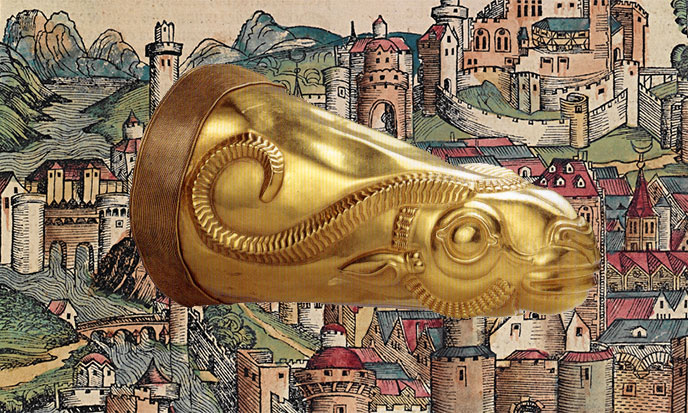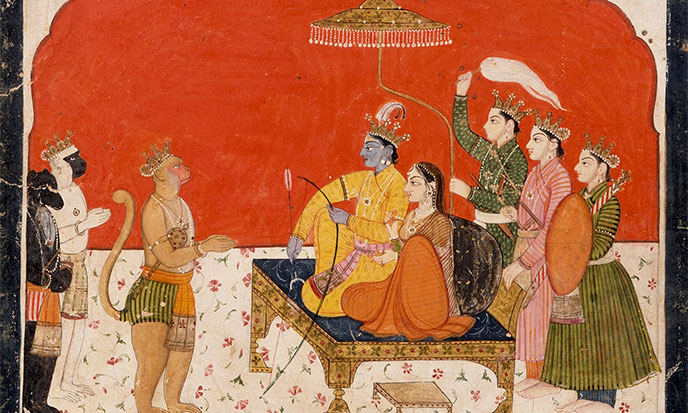
While New Atlantis threatened to tear into a fratricidal struggle, Rama the Shepherd of Armen,Ar = country men = stone. Country of Stone or Middle Earth: i.e. the New Atlantis faithful to the tradition of Atlantis, resolved to emigrate with those who would follow.
Rama was a quiet man who always chooses to negotiate rather than fighting. Coming from a humble background, he became a healer after his initiation by lightning at Avebury, in the sacred tradition of Armen, the Country of Stone. Quarrels and discord then shook Middle-earth. Faithful to the ancient science, Rama conceived the project to go eastward in order to conquer an empire where the tradition inherited from Atlantis could find blossom and bear good fruit.
“Rama had given appointments to his supporters in the plain of Hanover, north of the Teutoburg Forest, where the massacre of the army of Arminius Varrus is usually located. The day of departure was fixed for the Spring Equinox. In this quite desert land, was organized the gathering of volunteers – little more than twenty thousand men who, by the way, would snowball. In this crowd, there were several whole clans, starting with that of Rama.” (source)
Initially, the band was more of the exodus as a military expedition. Thus Homer in the adaptation he did, took care to separate the war and wandering into two separate books, the Iliad and the Odyssey. Note that Rama and his captains still had access to the ancient Atlantean technology: while he was a shepherd son, Rama was originally a magician, great initiate and warlord. He brought together quite well in him the fabulous figure of Merlin the magic druid and that of Arthur the warrior prince.
Comparison is not reason, but the captains of Rama are models that later inspire the famous Knights of the Round Table. But the Atlantean technology was no longer used by Middle-Ages knights, while the captains of Rama had several flying machines called vimanas and a fast ship called vailixi as I explained in Rama’s Airlines. If these vehicles were not enough to carry all his people, they were decisive in the war expeditions to reconnaissance patrols and assault.

Most of the clan, however, should follow the land path with arms and baggage.
“The emigrants were in the valley of the Elbe to reach the Danube and along the left bank where already camped Celtic clans from which some elements joined them. Without much skirmishes, they arrived at the river mouth, wisely avoiding clashes with Black people along the right bank and with the irreconcilable Amazons of Thrace. After a pause made necessary by the exigencies of supply, the exodus continued. The Black Sea is skirted to the north to win Armenia which made the first sustained drop (probably from one harvest to another) and not only for supply problems.” (source)

Indeed, Armen’s exiles who came once from Hyperborea were entrenched there for several centuries. They are the ones who gave name to Armenia, from their own name, Armen, those of the Stone. This region is characterized indeed by many megaliths. Comforted by this ancient and familiar presence, some of the companions of Rama settled there, replaced in the ranks of migrants by many young Caucasian Celts thirsting for adventure.
“And the exodus of Rama continued further through the Susa, Persia, Carmania where Rama stopped some time before entering India. It was populated mostly by descendants of survivors of Lemuria, the Black race, with a small proportion of Yellow, other survivors but of the Pacific continent. Indus was crossed in the Katchi plain, to the current Shikarpoor and conquest of the country started by the Indo-Gangetic plain.” (source)
This was the origin of what was then called the Rama Empire, which many relics were found in the proto cities of Mohenjodaro and Harappa – civilization of the Indus Valley.

“As one result of this conquest, a part of aborigines spontaneously joined the federation proposed by Rama who always opposed the unnecessary shedding of blood, another part being repressed southeast while remaining reluctant to ally or to fight, chose to emigrate, taking in reverse the route followed by the Ramas. These are immigrants who founded later Sumerian empire and Akkadian Babylonian empire.
Respecting local prides, making equity the wisest diplomacy, Rama pacified and federated India, extending his own suzerainty or rather his moral authority over Persia, where other Whites expelled or emigrated for similar reasons were organizing, displacing Black people whose decline would quickly increase. It was the same for Tibet where an ancient Hyperborean migration due to glaciation, had more or less merged with elements of the Yellow race.” (source)


